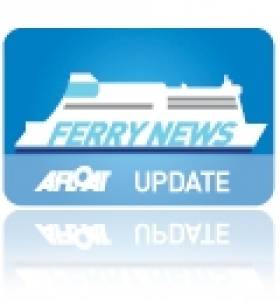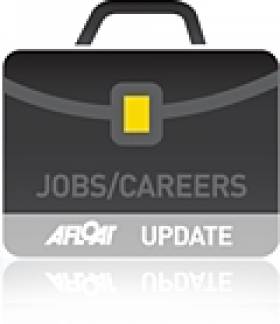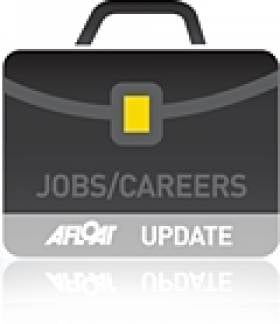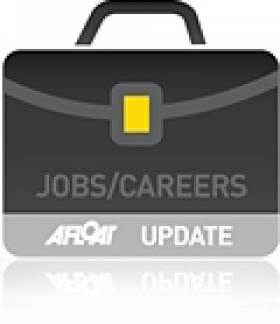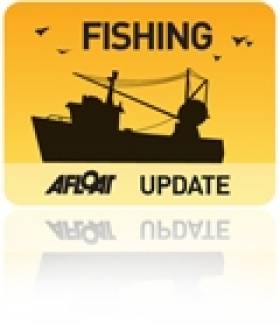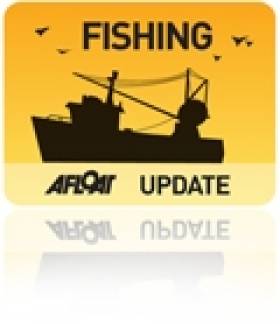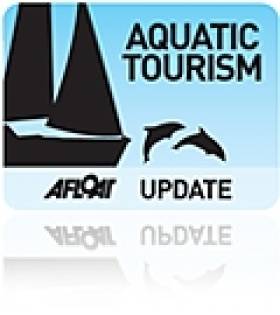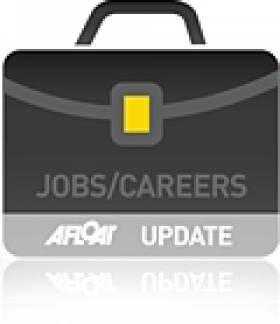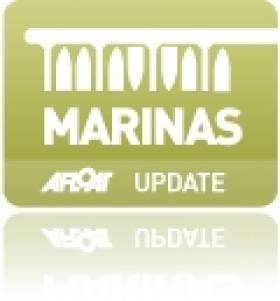Displaying items by tag: jobs
Minister Launches Consultation on Harnessing Ireland's Ocean Wealth
#NEWS UPDATE - Minister for the Marine Simon Coveney has launched a public consultation process on harnessing the potential of Ireland's vast marine resources.
Our Ocean Wealth is calling for input into how Ireland can best capitalise on the trillion-euro global market for marine products and services, from seafood and tourism to shipping, oil and gas, renewable ocean energy and marine science.
Launching the consultation, Minister Coveney said: "We need to change the way we in Ireland think about the sea and look for new opportunities to harness the potential of our 220-million-acre marine resource.
"This government is determined to generate the momentum to drive forward a new era of sustainable economic development across the maritime sectors - we must avail of these opportunities to assist in our recovery. We want your help to shape our plan, to shape our future and to assist in our drive towards our nation's economic recovery."
The consultation process is a step towards developing an Integrated Marine Plan for Ireland intended to grow the percentage of GDP generated by the country's marine resource, which covers an area 10 times the size of Ireland's land mass.
The minister added: "We need an Integrated Marine Plan to harness our ocean wealth, get the environment right for investment and use the potential of our marine economy to create jobs in a sustainable manner."
The consultation phase will be open until 31 March with an aim to publish the Integrated Marine Plan during the summer. For more details visit www.ouroceanwealth.ie.
Fastnet Line Closes For Good
#FERRY NEWS - The Fastnet Line ferry service between Cork and Swansea is to close with the loss of 78 jobs.
As previously reported on Afloat.ie, the operator had been in examinership since last November, and a restructured business plan had been submitted with a view to resuming high-season service in April.
However, in a statement the owners of the Fastnet Line said they had been unable to raise the €1m-plus investment required and that the examinership had "failed".
All 78 jobs will be lost as the company is set to be placed in receivership or liquidation later today.
The Fastnet Line - which was worth around €30 million to Cork in tourist spending - made its maiden voyage from Swansea to Cork in 2010, and was the only direct passenger and freight link between Wales and the south coast of Ireland.
The Irish Times has more on the story HERE.
Lough Ree Yacht Club Seeks Instructors for Summer Sailing Courses
#JOBS – Lough Ree Yacht Club is seeking Dinghy Instructors, racing Instructors and advanced sailing instructors for its Junior Sailing Course in July. Application Forms are available on www.lryc.ie
Titanic Belfast Bosses Want the ‘T Factor’ in Frontline Job Audtions
#TITANIC - Prospective employees at the soon-to-be-opened Titanic visitor centre in Belfast will have to show the ‘T factor’ and give a performance on aspect of the doomed ship’s story, The Irish Times reports.
It’s hoped by bosses at Titanic Belfast that the three-minute scripted ‘interpretative presentation’ - based on one of the centre’s nine galleries - will indicate those candidates with the requisite passion and communications skills for one of the 70 “frontline” jobs up for grabs.
“The audition day will give prospective employees a chance to let their true personalities shine through,” said Titanic Belfast chief executive Tim Husbands.
Titanic Belfast will be one of the largest employers in Northern Ireland’s tourism industry when it opens in March, as well as one of the North’s largest recruiters.
Among its many attractions, it will also bost the region’s largest function suite for conference, weddings and other events, as previously reported on Afloat.ie.
The Irish Times has more on the story HERE.
Galway Sailing School Launches 'Careers at Sea' Expo
#JOBS – Galway sailing school Bow Waves is taking steps to combat the unemployment crisis at home with its own "Careers At Sea Expo" next month. The event will take place on the 4th of January at 7pm at the Galway Radisson BLU Hotel.
Many areas of the marine industry have proven to be unaffected by the economic downturn says the firm's Barry Comlon who has joined the Bow Waves team as Chief Instructor having just come back from Canada where he was working within the Cruising and yacht charter business in Vancouver.
Conlon believes there is a worldwide demand for qualified marine personnel and to help people take advantage of these opportunities, the Bow Waves "Careers At Sea Expo" will showcase the range of careers available to people, and how to gain entry into the field.
The Expo will feature informative talks by several different speakers with professional experience of working at sea. The talks will cover a wide range of career opportunities including; crewing and skippering of offshore vessels, super yacht skippering and crewing, instructing, charter industry, deckhands, and the wide range of job opportunities in the cruise ship industry.
Each talk will be approximately 20 minutes in length and will outline how each speaker got started in their line of work, the speakers' professional experience, any pitfalls they encountered and how to avoid them.
Each speaker will outline what training they required for their jobs, and Bow Waves will make a presentation on the relevant training courses that they run from their centre in Galway. There will be a Q&A session with each speaker following their talk, and the Bow Waves team will be on hand to answer any questions or queries regarding the training that they provide, as well as providing career guidance.
The evening will be invaluable for anyone considering a career change or working abroad, and is open to everyone. You do not need any experience of the marine sector or boating to attend. Tickets for the evening cost €10, to reserve your space ring Barry on +353 91 560 560 or e-mail [email protected]
Licence Application for Aran Islands Fish Farm 'To Be Lodged in January'
#FISHING - The licence application for a proposed new deep-sea fish farm in the Aran Islands is expected to be lodged in January.
As previously reported on Afloat.ie, Bord Iascaigh Mhara's (BIM) planned 15,000-tonne organic salmon farm off Inis Oírr would be the largest of its kind in Europe, and would create hundreds of jobs in the area.
Commenting on the plans, Galway West Senator Fidelma Healy Eames said it was "a major opportunity for Galway and would represent a very significant economic boost for our coastal communities."
She added: "Deep sea fish farming has proven to be very economically beneficial in countries such as Norway, Chile and Scotland. It is timely that Ireland would capitalise on our fantastic marine resources as these countries have."
According to Healy Eames, the project is expected to "meet all environmental standards and will be barely visible from 2km away and effectively not visible from land.
"It would take up a negligible amount of inshore fisheries ground in the bay (0.22%) and would not interfere with existing fishing routes or Galway Bay ferry routes."
Europe's Largest Organic Fish Farm Proposed for Aran Islands
#FISHING - Bord Iascaigh Mhara (BIM) has begun the consultation process for a proposed new deep-sea fish farm in the Aran Islands, The Irish Times reports.
The 15,000-tonne organic salmon farm would be located off Inis Oírr on a 500-hectare site in Galway Bay, and would be one of the largest of its kind in Europe.
Approval of the project could see the creation of 350 direct and 150 indirect jobs, says BIM. It will be owned by the body on behalf of the State but leased to operators on a franchise basis.
The scheme has been welcomed by Comhar Caomhán Inis Oírr, but the island co-op said it was important that a promised €8-million pier for the island is constructed first to provide the necessary infrastructure.
The Irish Times has more on the story HERE.
Killybegs Report Shows Maritime Jobs Potential
#JOBS – 250 jobs could be created over a three year period across five key maritime areas in Killybegs according to a report launched by the Minister for Agriculture, Food and the Marine, Simon Coveney TD,
Minister Coveney set up the group on the 3rd June this year following the Economic Report for the European Commission, which assessed the status, development and potential diversification of Killybegs as a fisheries dependent community. The Group comprising of representatives from the Irish seafood sector, tourism, education, enterprise and the Department of Agriculture, Food and the Marine were tasked to identify potential jobs across key areas including seafood, ancillary services, offshore supports, tourism and marine leisure and green economy/renewable energy.
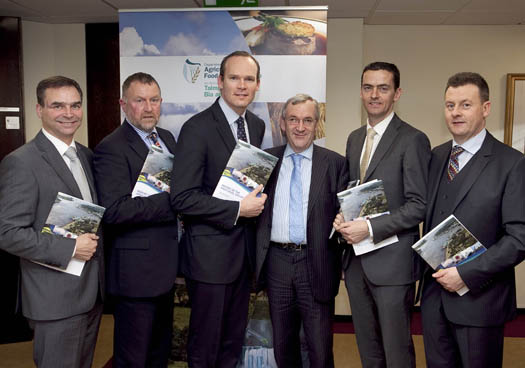
Minister for Agriculture, Food and the Marine, Simon Coveney with Sean O'Donoghue, Chairman, Chief Executive, Killybegs Fishermen's Organisation Ltd, Cecil Beamish, Assistant Secretary, Department of Agriculture, Food and the Marine, Seamus Neely, County Manager, Donegal County Council, Jason Whooley, Chief Executive, Bord Iascaigh Mhara (BIM), Paul Hannigan, President, Letterkenny Institute of Education, Jim Parkinson, Representing Offshore and Ancillary Services, Niall O'Gorman, Representing Donegal Fish Merchants Association and Conor Fahy, Regional Director, Enterprise Ireland at the launch of a report on Job Creation in the Killybegs Region.
Minister Coveney commented at the launch; "I set ambitious targets for the group and I am very pleased to see that the group has not only clearly outlined how 250 jobs can be achieved but has also identified new areas where additional jobs can be created into the future. The importance of the seafood sector to Killybegs region cannot be overstated as it is responsible for 68% of the workforce. The Group has identified that through greater diversification and adding value to our existing resources, 130 jobs will be delivered in this sector. The Group are to be commended for working together to complete this task in the allocated time and I am looking forward to seeing the actions from the report completed and the benefits that they will bring to the people of Killybegs".
The report outlines 250 jobs to be created over a three year period across five key areas. In total, 130 potential jobs were identified within the seafood sector. The expected increased access to raw materials such as blue whiting and boarfish present the most significant opportunities, along with a concerted focus on value adding opportunities. Within the ancillary services, 24 jobs were identified if collaborative opportunities between various companies can be enhanced and their abilities promoted. The offshore sector could generate 20 jobs, however competitive service provision and appropriate skill resources are deemed fundamental to achieve this. Approaching 50 jobs were identified within the tourism/marine leisure area if a co-ordinated marketing strategy is developed, whilst the green economy and renewable energy area offers the potential to create up to 40 jobs.
The Minister added "This pilot approach of co-ordinated developmentally focused activity which is concentrated on natural resources has delivered results that will drive economic development and job creation in the Killybegs region. An example of this is the partnership between BIM and LYIT to address seafood value added activities. As a direct result of this jobs initiative, the College of Catering in Killybegs will become a focus for industry activity beginning with a workshop on new product development for crab suppliers is already planned for the 30th November".
Members of the High Level Group are:
Sean O'Donoghue, Chairman, Chief Executive, Killybegs Fishermen's Organisation Ltd
Cecil Beamish, Assistant Secretary, Department of Agriculture, Food and Marine
Seamus Neely, County Manager, Donegal County Council
Jason Whooley, Chief Executive, Bord Iascaigh Mhara (BIM)
Paul Hannigan, President, Letterkenny Institute of Education
Jim Parkinson, Representing Offshore and Ancillary Services
Niall O'Gorman, Representing Donegal Fish Merchants Association
Conor Fahy, Regional Director, Enterprise Ireland
Sailing Clubs Offer 2012 Instructor Jobs
The National Yacht Club is seeking a senior sailing instructor for its summer courses that run from from the 4th June to the 6th of July and the 23rd of July to the 17th of August. Please send a CV, stating previous instructing experience, sailing experience and qualifications by email to [email protected]. Closing date is 30th of November 2011.
Cullaun Sailing Club are also seeking Junior ISA Dinghy Summer Course 2012 Instructors. One Senior Instructor and two Junior Instructors, who are accomplished dinghy sailors, are required. The course runs 2nd-13th July. Please forward your CV to [email protected]
Courtown Sailing Club are seeking a senior sailing instructor for July and August. Send your CV to The Secretary, Courtown Sailing Club, South Pier, Courtown, Co. Wexford or [email protected] or phone 086 8066594
New Marina for Cork to Create 32 Full Time Jobs
#JOBS – Cork County Council have issued a notice of intention to grant planning permission to allow the expansion of Cork Harbour Marina, Monkstown to a larger and more comprehensive 285 fingered berth marina as reported previously on Afloat.ie. The expansion will allow for 175 car parking spaces, a marina pavillion building to incorporate a provisions shop, cafe/bar/restaurant, chandlery, marine and boat sales office, Gym, changing rooms with showers, toilets and laundry facilities. All 285 berths are fully serviced, secure fingered berths ranging in size of up to 18m in length, a reception berth, a fuelling berth with diesel and petrol available and a pump out facility berth. The car park and pavillion will be encompassed by a public promenade with seating, panoramic viewing platform, viewing deck promontory and a nature awareness garden.
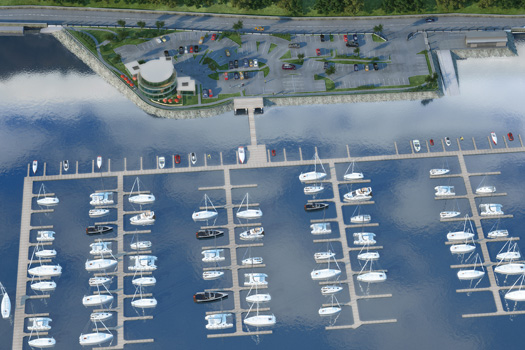
An artist's impression of plans for an expanded marina at Monkstown
This expansion will lead to one of Ireland's finest marinas facilities which will support up to 90 jobs both directly and indirectly, of these 32 will be full time permanent jobs on the completed Marina complex. The Marina is a unique development, destined to be the South of Ireland's first Blue Flag marina with world-class facilities for berth holders and visitors alike which will allow Cork to capture a bigger slice of the world marine leisure market worth approx €928 billion annually. Initially, set up to address the deficit of safe berths in the Monkstown Bay area the facility is a credit to the Irish team that invested, designed and built it, and of their ambitious plans for its expansion to a five star facility to rival any that Europe has to offer.
A €1.5 million investment into the Irish economy was required to complete the first phase, namely an 82 berth state of the art floating concrete marina. Project co-coordinator James O'Brien advised that "having secured a grant from SECAD (South and East Cork Area Development) and private investment, Monkstown Bay Marina Company proceeded with the totally Irish construction project. All local contractors were employed, from engineering to carpentry to provision of water supplies, to mooring and anchoring specialist teams".
When questioned if he felt that it was wise to undertake such a project during a recession, Mr O'Brien felt that the project will actually help Cork recover from the recession, "In recent years, the lack of marina and berthing facilities in Cork Harbour, the second biggest natural Harbour in the world has been recognised as having a negative impact on the amount of yachts and marine leisure holidaymakers visiting the harbour, and utilising onshore facilities, both in the in the immediate locality and Cork County". Located just 7kms from Ringaskiddy Ferry Port, with access to the UK several times a week and Roscoff in France once a week. A weekly service to Spain is also under negotation, at this time making Cork Harbour Marina the ideal place to winter a visiting boat or to place it in Ireland for multiple family visits, and with the world class cruising grounds of West Cork.
Having a slip (or berth) at a marina offers convenience, security, services, amenities, and a social atmosphere to enjoy. There are broader quality of life benefits for users also, such as improved safety, to-and-from access, and the availability of other essential services, such as electricity to effect repairs, fuel at a convenient marina location, or provisions, parts or repairs being delivered directly to any boat as necessary. Berth spaces are currently available to rent long and short term, at competitive costs.
The boating public have eagerly awaited the new marina for many years, and the response has been one of huge endorsement and positivity, with rapid take-up of berths, and a high incidence of short stay and overnighting too, all bringing much needed tourism revenue to a village that most, up to now, would have sailed or motored past!
Cork Harbour Marina offers an asset-backed; Bord Failte approved BES scheme, in one of the only tax shelters left available to the Irish investor. Full details of this BES scheme are available on request. Berths are allocated on a first come first served basis, all enquiries regarding berthing space should be directed to James O'Brien on 087 3669009
Monkstown is an attractive seaside village that offers visitors beautiful walks in a stunning location - even walking the marina, visitors can enjoy this tranquil and picturesque harbour setting.
South of the city, the marina is also served by a regular bus route, No 223, allowing easy access to Cork City's shopping and social scenes, one of the top cities in the world for a short break, according to a recent Trailfinder survey. Cork Harbour Marina is also only 2kms from the Cross River Ferry, giving easy access to Great Island and East Cork.
For those choosing to stay for an extended period, various ancillary services can be organised - provisioning, refuelling, cleaning, antifouling, boat maintenance and repairs, sail repair, and winter storage both outdoor and covered. The marina team can also organise a boat delivery or recovery service provided by competent Offshore Yacht masters.
Cork Harbour marina is the closest marina to the suburbs of Douglas, Rochestown and Passage West, nestles right in front of the stunning Monkstown village, is convenient to Monkstown Sailing, Rowing, Golf and Tennis Clubs, and the world renowned Bosun Restaurant and Guesthouse, the convivial Monkstown Inn, and the proposed Monkstown Amenity Park, which the local communities are pushing toward completion.
In brief, Cork Harbour Marina is Ireland's newest coastal marina with all year round berthage. The marina itself can accommodate boats up to 17m and consists of an outer perimeter of floating concrete break waters with fingered berths contained internally.
View Larger Map



























